The Zero Inbox Strategy
What is Inbox Zero in Gmail? By now, you’ve heard the phrase and may’ve even tried to master this technique of mailbox management. To achieve Inbox Zero, you’re supposed to work through messages until you’ve sorted, replied, removed, or acted on them to get your inbox down to zero. You should then have a clearer mind to work on other tasks.
While this sounds well and good, is it really possible?
When the concept of Inbox Zero was introduced by Merlin Mann many years ago, it may have been. But things have changed. Many of us now have several email accounts with various service providers for personal, business, and school emails. To reach Inbox Zero for all of them could easily consume an entire day!
With all of this in mind, will a clean Gmail inbox by day’s end make you feel productive and organized?
If so, then Inbox Zero may be the ideal method of mailbox management for you. If not, and you find that you’re actually spending more time managing emails and less time on higher priority tasks, then maybe you should try something new.
Is Inbox Zero Bad?
Absolutely not! If that’s the strategy you want to use, go for it. For me, having zero emails in my inbox just isn’t feasible. Each day, more and more messages pile into my mailboxes and it’s exhausting, not to mention overwhelming, trying to take care of them all.
Instead, I use methods to better organize my inbox and optimize Gmail for productivity rather than work toward zero.
That being said, you can certainly use the guides below to reach a Zero Inbox in Gmail! Or you can just use them to gain a more organized mailbox. Either way, you’ll ease the task of email management and reduce inbox overload.
How to Get to Inbox Zero in Gmail
For a Zero Inbox in Gmail or simply an organized one, below are the strategies that work best for me.
📌 Tip: Before you get started, check out how to mass delete emails in Gmail for a clean sweep.
Set Up Filters or Rules
Email filters are Gmail automations that manage messages for you. Whether you want to mark, move, or forward incoming messages, filters and rules handle it for you. This is an ideal way to organize emails as they arrive.
Use Gmail Filters
In Gmail, filters work like inbox rules. You set up the conditions and choose an action to take on matching messages.
- Select the Settings icon (gear) and choose See all settings.
- Open the Filters and Blocked Addresses tab and click Create a new filter.
- Enter the conditions for the filter. You can use From for the sender, Has the words for a keyword, or Has attachment checkbox for messages with files.
- Select Create filter.
- Choose the action you want to take on matching messages. You can pick one or more per your preference including applying a label, marking as read, or forwarding to another address.
- Optionally mark the action to apply the filter to existing messages.
- Select Create filter.

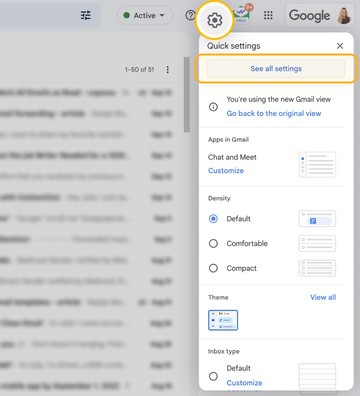

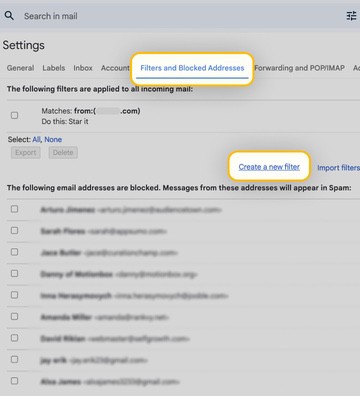
Use Clean Email Rules
Clean Email is a powerful email cleaning app designed to efficiently organize your cluttered inbox. Using its features, you can set up inbox rules to handle incoming emails. Like Gmail filters, you pick the conditions and action to take. However, Clean Email lets you choose from more flexible options.
- Select Auto Clean in the menu and choose Create Rule or the plus sign on the top right.
- Enter the conditions for the rule. You can choose a sender, enter a keyword, or mark attachments, but you can also select a status, sent by an automated system, or by timeframe.
- Choose the action in the drop-down box at the bottom. You can mark the message, flag it, move it to a folder, trash it, or set it to Read Later.
- Optionally apply the rule to existing messages.
- Select Create Rule.
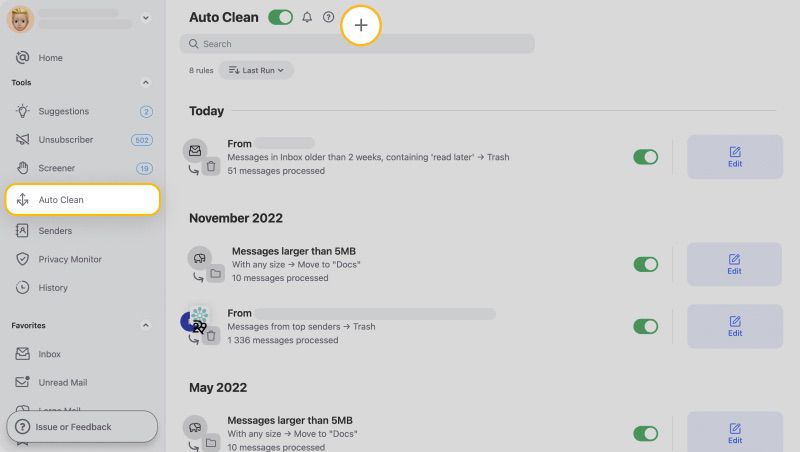
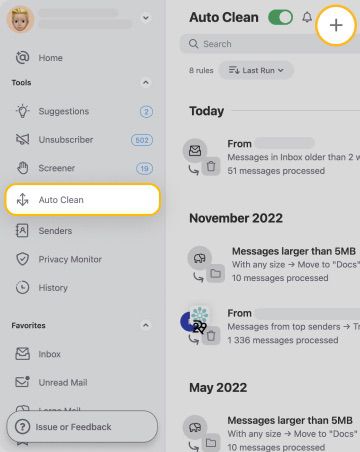
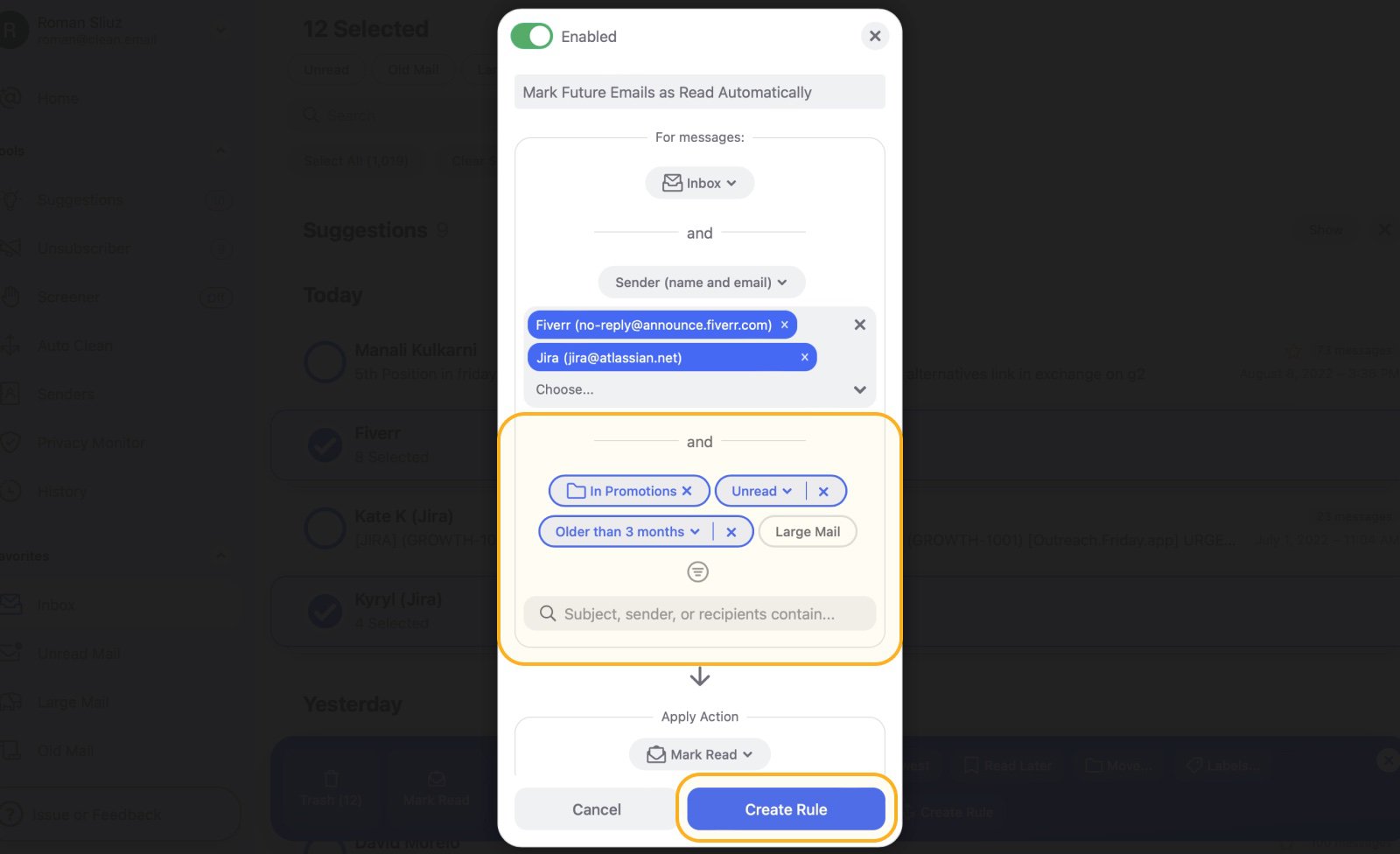
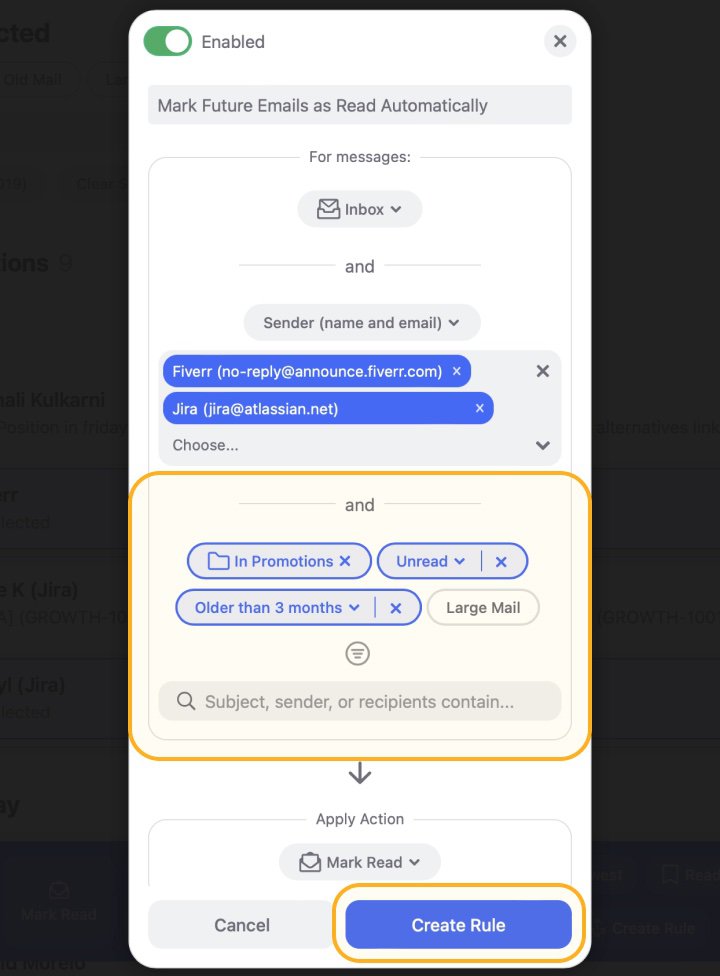
Unsubscribe From Mailing Lists
If you continue to find yourself on new mailing lists, consider unsubscribing from those you don’t want. This is the perfect way to rid your inbox of unwanted marketing and promotional emails.
Unsubscribe in Gmail
In Gmail, you can unsubscribe using a button.
- At the top of the email, click Unsubscribe.
- In the pop-up window, pick either Unsubscribe to confirm or Go to website to complete the process. The option you see depends on the sender’s unsubscribe settings.
- Optionally select Move to spam to send the current message to the Spam folder.
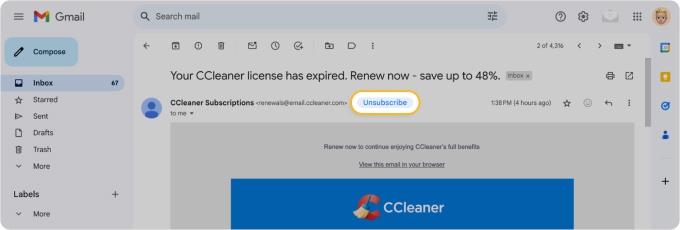


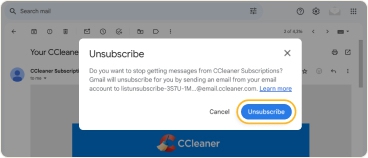
It can take a few days for the unsubscribe process to complete, so you may receive additional emails in the meantime. But after that, further messages from the sender go to your Spam folder.
Unsubscribe in Clean Email
In Clean Email, you can use the Unsubscriber tool to stop unwanted messages. The advantage here is that you can unsubscribe in bulk, rather than clicking a button for each individual message.
- Select Unsubscriber in the menu and you’ll see your mailing list messages grouped by sender.
- Do one of the following:
- Pick Select at the top, mark each group or use Select All, and click Unsubscribe at the bottom.

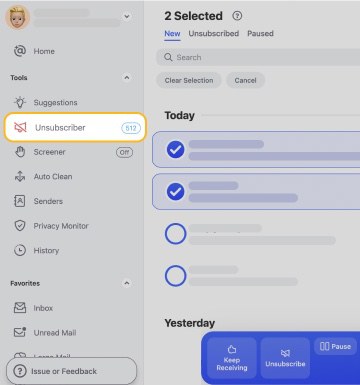
- Choose Unsubscribe to the right of a particular email group.

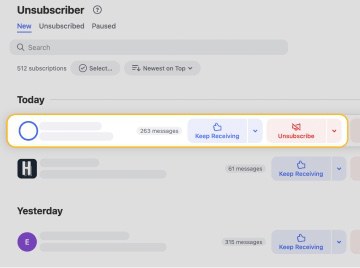
Future messages go directly to the Trash folder and there’s no waiting for the unsubscribe process to complete.
Mark and Remove Spam
No matter how hard we try, junk emails continue to land in our inboxes. But, if you don’t mark messages as spam in Gmail, those particular senders will continue to email you.
Mark Spam in Gmail
In Gmail, you have a couple of quick ways to mark spam.
Select the email and either click the Report spam button (stop sign) in the top toolbar or use the three dots in the message to pick Report spam.
Mark Spam in Clean Email
In Clean Email, you can easily mark a message as spam or use the Suggestions (described below) which can help identify spam from the get-go.
Do one of the following:
- Select a message, click the arrow next to Trash on the right, and pick Spam.
- In Suggestions, either select Spam to the right of a message group identified as junk or click the arrow on the right and pick Spam.
Effective Clean Email Features for Mailbox Management
Along with the features above, there are additional Clean Email tools that can help you organize Gmail and declutter your inbox. Here are a few of the features I find most helpful that you can also use to reach Inbox Zero Gmail status.
Smart Folders: While you can create rules to move specific emails to folders in Clean Email, you can also use the built-in Smart Folders.
Clean Email automatically filters emails into 33 folders like Social notifications, Finance and Insurance, Online shopping, Entertainment, and more. All messages you receive related to a Smart Folder are placed in the corresponding folder making them super easy to find.
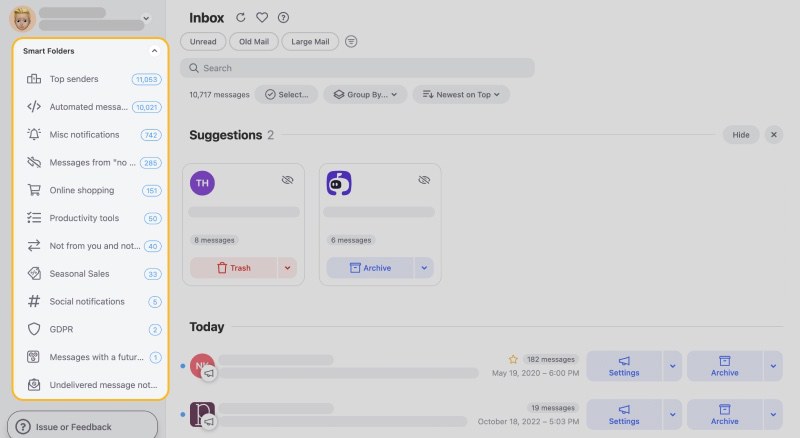
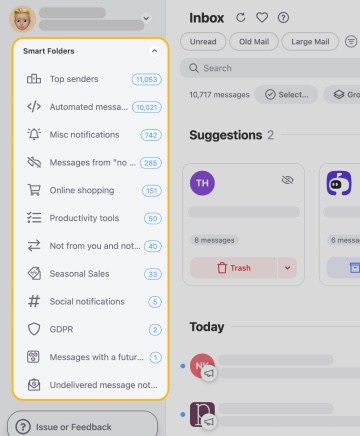
Screener: When you receive messages from unknown senders, Clean Email captures them all in the Screener section. This gives you a terrific way to spot emails from people you don’t know. You can then allow the messages in your inbox, block the sender, or unsubscribe.
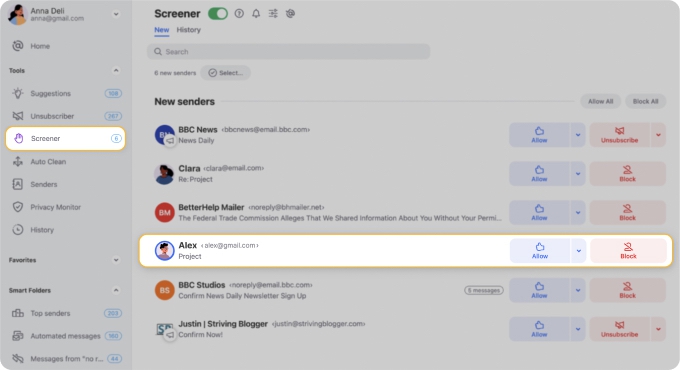
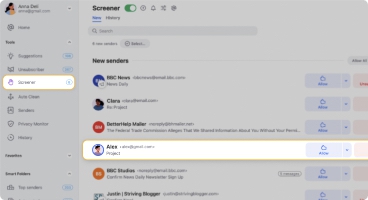
Cleaning Suggestions: If you’re like me, you sometimes scan an email and then move onto the next without taking any action. Over time, those messages needlessly pile up.
With Clean Email’s Cleaning Suggestions, you receive recommendations for what to do with messages. And what’s great is that the emails are grouped for you. So, you can use the suggestions to archive, trash, or mark spam for groups of messages with a single click.
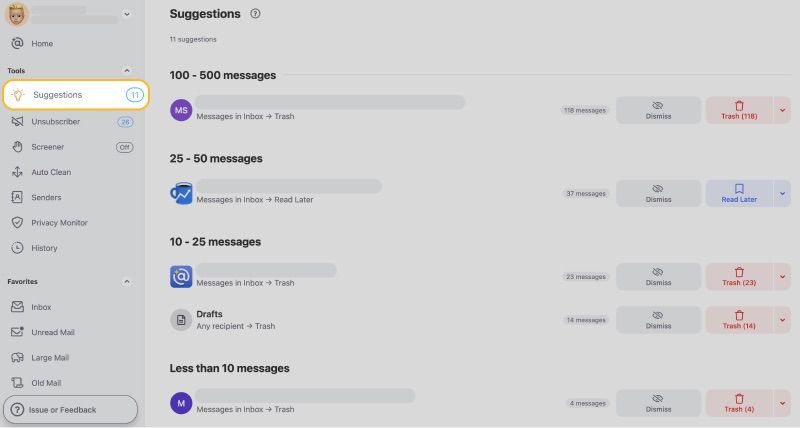
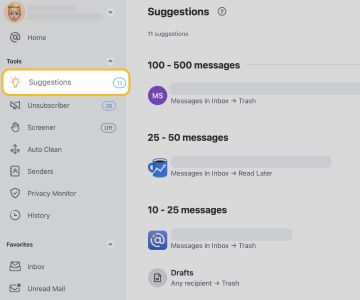
Gmail Inbox Zero - FAQs
What is Inbox Zero in Gmail?
Inbox Zero in Gmail is the practical application of the email management ideas described by Merlin Mann. The goal is to prevent emails from piling up and making the mailbox difficult to manage. To achieve this goal, you can use Gmail’s native email management features in combination with third-party solutions such as the Clean Email inbox sorter app.
How do I get Inbox Zero in Gmail?
To get it, you need to create an effective strategy that reflects the way you use your mail service provider. You then need to use its inbox management features in combination with apps like Clean Email to reach the Zero Inbox Gmail status.
Why is my Gmail inbox suddenly empty?
If it is suddenly empty, then you've accidentally archived emails, deleted them, or moved them to the spam folder. Even if your emails have ended up in the Trash folder, you should still be able to recover them within 30 days of their deletion.
Should you empty your email inbox?
We don’t recommend you empty your inbox without organizing it first and taking the steps necessary to ensure that it won’t become a mess again. The tips described in this article can help you accomplish both.
Why is Inbox Zero bad?
Inbox Zero isn't inherently bad, but obsessively striving for it can lead to stress and prioritize quantity over quality in email management. It may also neglect important emails in the pursuit of an empty mailbox.


